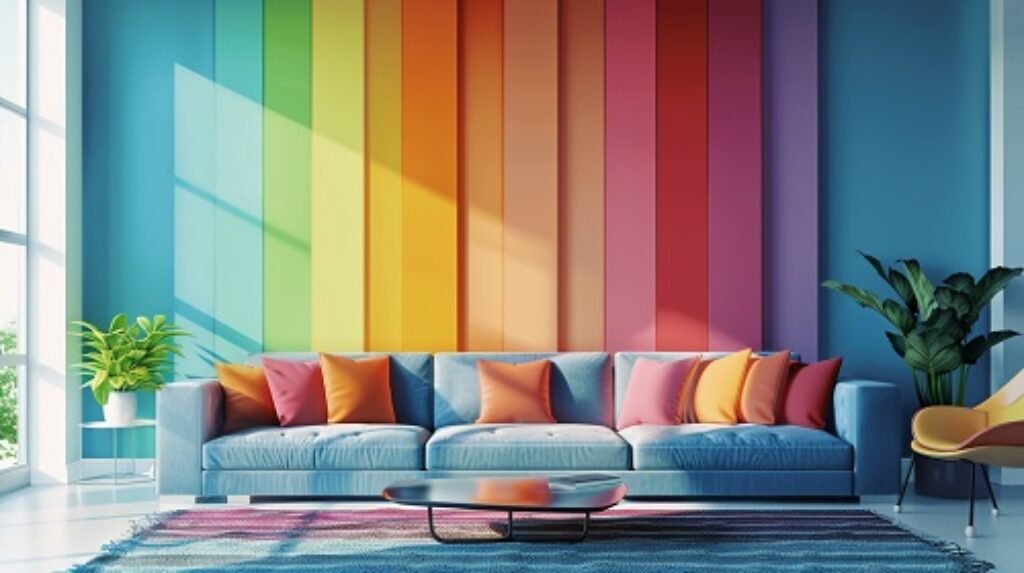Table of contents:
- Introduction:
- Understanding the Impact of Color Psychology in Home Décor
- Exploring Paint Color Trends for a Modern Living Space
- Complementing Your Décor with Complementary Colors
- Monochromatic Palettes and Their Tranquil Appeal
- Transformative Accent Wall Ideas to Revamp Your Room
- Creating and Using Mood Boards for a Cohesive Vision
- How Room Lighting Influences Color Perception
- Seasonal Color Updates: Keeping Your Home Fresh All Year Round
- Conclusion
- FAQ
- Source Links
Introduction:
People spend about 15,000 hours looking at the walls of their living rooms. This makes choosing the right colors very important. We want your home to be a personal retreat and a style statement. With our home decor color suite tips, your living space will be beautiful and charming.
Think about what vibe you want in each room. Do you want your living room to be calm for quiet times or lively for parties? Picking the right color schemes by room matters a lot. Mood boards help you choose colors that go together, from curtains to furniture.
Deciding on colors is about finding balance. Do you prefer soft, neutral tones or bright, bold hues? Your taste guides this choice. Think about what colors make you feel at home or get you ready to tackle the day. Plus, you can always switch things up with the seasons. This ensures your home remains inviting and up-to-date.
Key Takeaways
- Dedicate time to creating a mood board before selecting your living room’s color palette.
- Consider the main use of your living room to influence your color choice.
- Create the right space with colors that balance well and show your style.
- Lighting can change how colors look, so keep that in mind when choosing.
- Stay fashionable by updating your home decor with the seasons.
Understanding the Impact of Color Psychology in Home Décor
A well-designed color scheme is the heart of a beautiful home. It does more than just look nice. The right colors can boost our mood and well-being. Understanding how colors affect us is key to creating a home that feels good.
The Mood-Enhancing Power of Color
Color isn’t just for looks. It can change how we feel in a room. For example, soft blues and sage greens can make a room feel calm and welcoming. These colors mimic nature, bringing a sense of peace indoors. This turns your home into a peaceful retreat.
Choosing the Right Colors for Your Emotional Well-being
Picking the right colors for your home is important. Choose shades that make you feel good, calm, or happy. Studies in color psychology show us how colors affect our mood. This makes choosing the right colors so important for our well-being.
Pairing the right colors can do wonders. Complementary colors are opposite on the color wheel. They make each other shine. This creates a beautiful space that also feels balanced and calm.
- Use light blue and pale orange for a fresh, creative space.
- Deep greens and earthy reds can make a room perfect for unwinding.
By following color psychology, our home can become a place that’s not only beautiful but also lifts our spirits.
Exploring Paint Color Trends for a Modern Living Space
Let’s look at the trendy paint colors for our homes. We aim to make our living areas stylish and cozy using new, popular colors. Elegance mixes with comfort this year, making our homes feel enriched and welcoming.
Popular Color Trends of the Year
Now, sage green and royal blue top the list of trendy colors. They bring a calm sense of sophistication to any room. Burnt orange and sky blue are also a hit. They add a warm glow and fresh color. It’s a great way to modernize and warm up our spaces.
Incorporating Trendy Colors Without Overdoing It
It’s important to use trendy colors wisely to keep our home chic and subtle. These colors work best as accents. Add them to things like throw pillows, vases, or art with a mostly neutral background. Also, unique furniture in trendy colors can be a great style addition without going overboard.
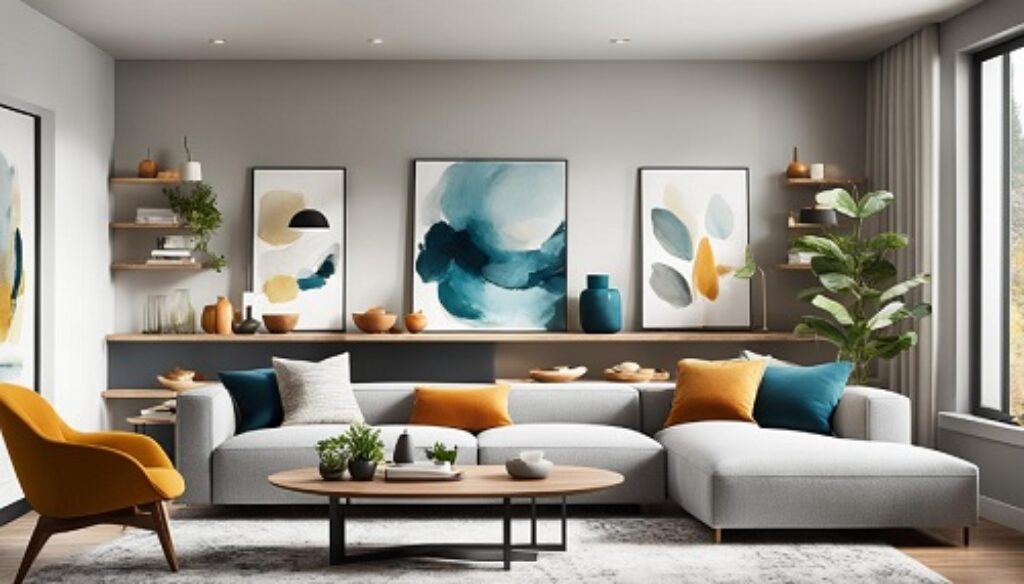
Using the right colors can change a room’s feel. With the tips mentioned, you can update your space to be current and sophisticated. It just takes a little careful planning.
Complementing Your Décor with Complementary Colors
Understanding complementary colors is essential for a well-decorated home. These color pairings create more than beauty. They bring a feeling of wholeness and calm to any space.
Finding the Perfect Complementary Color Pairings
To find the best complementary colors, look at the color wheel. Colors across from each other are often the best match. Combining, for example, burnt orange and sky blue, can make a room both lively and peaceful.
Using Complementary Colors to Create Visual Harmony
Rust and forest green, when used well, can set a room’s mood. They’re excellent for homes wanting a natural, soothing feel. You can use them in fabrics and textures to add a touch of elegance.
Using complementary colors is about more than looks. It’s about balancing your home’s feel. When colors are carefully chosen, your space becomes welcoming.
Monochromatic Palettes and Their Tranquil Appeal
The beauty of using monochromatic palettes at home is clear. These colors form a calming mix of shades and touch. They turn a house into a peaceful haven. By using only one color, they bring unity to a place. This gives our eyes a break from the busy mix of colors we usually see.
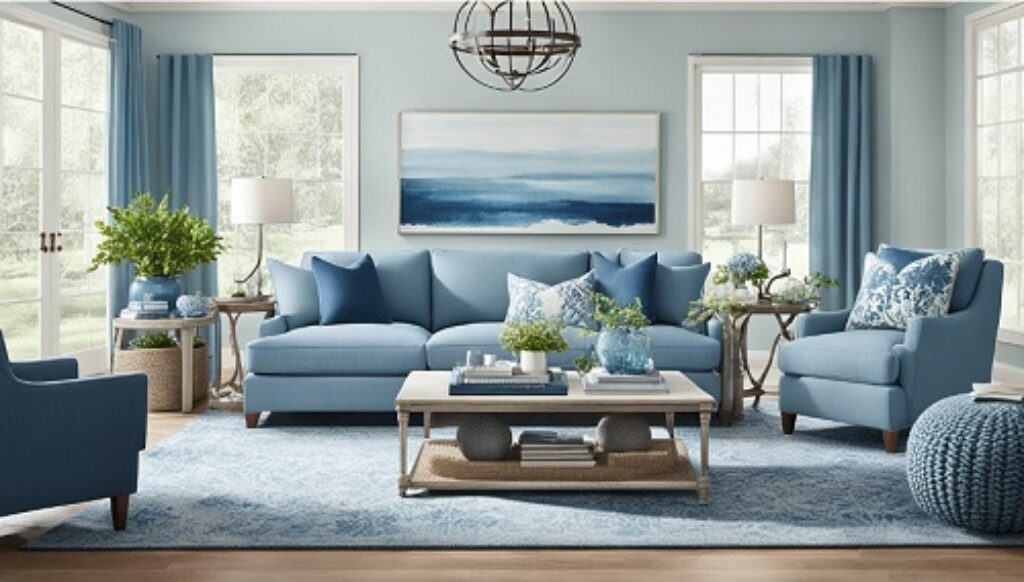
Choosing a monochromatic palette simplifies our decorating choices. It highlights a room’s best features and uses light effectively. The connected look of one-color designs benefits even the smallest areas. It makes them seem bigger and more complete.
- Choose a base color that resonates with the mood you wish to evoke.
- Vary textures within your chosen color to add depth and interest.
- Use lighter and darker shades to highlight different features and zones in your space.
Monochromatic spaces are perfect for creating peaceful rooms. Think bedrooms or relaxation spots. Single-color designs are simple and stylish. They also make a great backdrop for important items like furniture and artwork.
The charm of a monochromatic look is simple yet deep. It’s not just about the color. It’s about building a serene and welcoming home. This style defines a living space that is both elegant and comfortable.
Transformative Accent Wall Ideas to Revamp Your Room
Adding an accent wall changes more than colors—it transforms your whole space. Think about how a simple wall can make your room look and feel entirely different.
It’s not just about color. An accent wall can make a room’s vibe change. It can be a bright color, an interesting texture, or a cool pattern. The best part is it shows your unique style.
- Vibrant Colors: Pick a bold color like saffron against a light background for an interesting look.
- Texture: Add materials like grasscloth or wood for a more inviting, textured feel.
- Graphic Wallpaper: Choose striking patterns to tell a story with your accent wall.
Accent walls are key to changing how your home feels, making it fresh and exciting. Plus, they’re a cool way to be creative without a big makeover. So, pick a wall and see how it transforms your space with just a little effort.
Creating and Using Mood Boards for a Cohesive Vision
Mood boards help with home decor pre-design planning. They let designers and homeowners build a cohesive vision in decor. These visuals let us see and improve many design aspects before deciding for sure.
The Benefits of Mood Boards in Pre-Design Planning
Mood boards make decorating faster. You can organize fabric swatches, furniture photos, and color schemes to see a room’s vibe. It makes sure everything looks good together, boosting harmony and beauty.
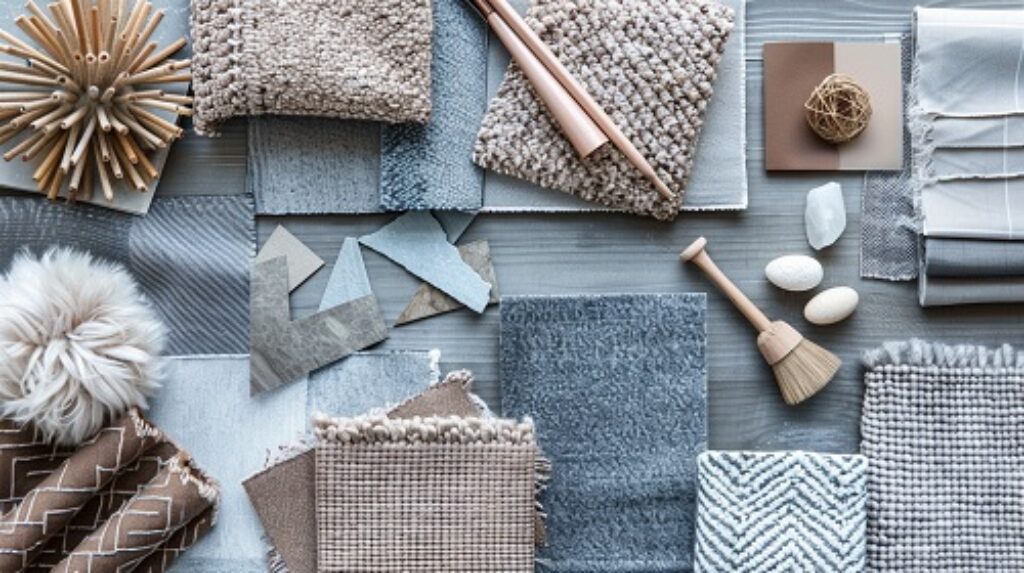
How to Create an Effective Mood Board
Start with picking inspiring images for your mood board. Then, add physical things based on your interior plans. Important items include:
- Paint chips in various hues
- Fabric samples for upholstery and curtains
- Flooring samples like wood, carpet, or tile snippets
- Photographs of desired furnishings or art pieces
Building a mood board like this is a key step. Each part is vital for the bigger design picture. A good mood board turns vague ideas into a clear plan for a lovely home.
How Room Lighting Influences Color Perception
The way lighting and colors mix is key to home decor. Different lights can change how we see colors in a room. Knowing this helps pick the best colors and lights. This creates the mood you want in your home.
Choosing the Right Lighting Fixtures for Your Palette
Finding the right lights is important to make a room look great. Great fixtures make the colors pop. For example, bright LED lights are good for rich colors. Halogen bulbs work well because they show colors as they are.
The Role of Natural Light in Color Presentation
Natural light can change how we see colors all day. The way light comes in, and its strength, changes color shades. Morning light can highlight soft colors, while mid-day makes bright colors stand out. Using mirrors can make natural light more powerful. This affects how we see colors.
Knowing how lighting influences color can make your space look better. It’s not just about picking the right fixtures. It’s also about how natural and artificial light work together. This is key to making your chosen colors come alive.
Seasonal Color Updates: Keeping Your Home Fresh All Year Round
Our homes change with the seasons. We follow yearly color trends and update our rooms with each season. This keeps our living spaces looking great and feeling cozy. It helps us stay emotionally connected to our rooms, too.
We add things like throw pillows and cozy blankets to keep up with color trends. This simple action can make any room feel new again. We change decorations with the seasons, from rich fall colors to bright spring tones. Doing this keeps our homes interesting and fun all year long.
- Spring: We often opt for soft pastels and flourishing greens to mirror the awakening of nature.
- Summer: Vibrant blues and lively yellows capture the energy of sunny days.
- Autumn: Earthy tones like oranges and browns bring warmth as the air cools.
- Winter: Rich purples and deep blues reflect the sophisticated mood of the season.
When we update our homes with the seasons, we do more than add style. We bring in a feeling of new beginnings that comes with each season. This way, our homes are always filled with decor that feels fresh and inviting.
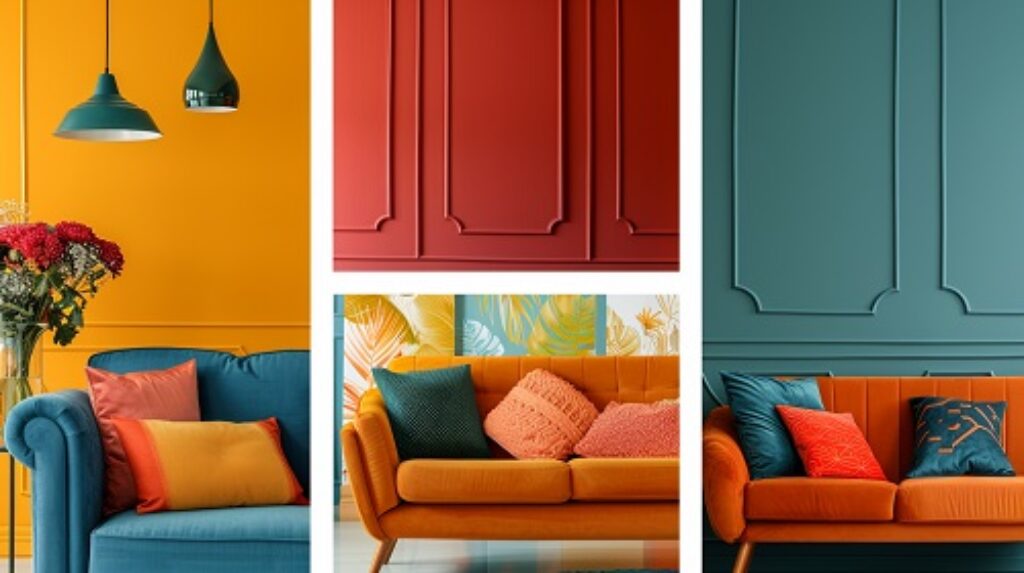
Conclusion
Looking back, color has a big impact on how we feel in our homes. We’ve learned that picking the right colors can make our living spaces stylish and inviting. By choosing colors based on what they mean, mixing modern trends with classic looks, and balancing different hues, we can transform our living spaces.
Monochromatic schemes offer peace while bright accent walls catch our eyes. This lets us tell our personal stories through design. Our trip showed us how planning with mood boards and smart lighting matters a lot. They help us create places that match our tastes and make us happy.
A simple change like a new color in a room can breathe new life into our home. It’s a way to keep our living areas exciting and in tune with the world around us. The goal isn’t just a beautiful look but a feel of energy and life in every room. This final step in choosing the right colors leaves us with homes that are both eye-catching and welcoming.
Our decorations make a space not only pretty but calming. With careful planning and creativity, our homes tell stories about us. They become places of comfort, reflecting our unique style and welcoming in the best memories. These are homes where happiness and beauty fill every corner.
FAQ
How can I use home decor color palette tips to elevate my living space?
For a stylish touch, think about room-specific color schemes. This makes your home feel unique. You can use things like pillows and art to bring your theme to life.
What is color psychology and how does it affect home decor?
Color psychology is the study of colors’ impact on our feelings. By choosing the right colors, you can shape the mood of a room. This makes your space comfortable and reflects your style.
How do I incorporate the latest paint color trends without overwhelming my space?
To use trendy colors without overdoing it, pick a focal area to paint. You can also add modern colors through small items like cushions. This keeps your space looking fresh.
What are complementary colors, and how can they enhance my home decor?
Complementary colors are opposite on the wheel but work well together. They help create a lively, balanced look in your home. It’s an easy way to make a room visually appealing.
Why might someone choose a monochromatic color palette for their home?
Monochromatic schemes use varying shades of one color. They make a room seem peaceful and coordinated. They’re perfect for those who love a quiet, unified space.
Can you give me some innovative accent wall ideas?
Accent walls can change a space. You could choose a bright color, textured wallpaper, or a mural. For something quieter, try wood panels or a gallery of your photos.
How do mood boards support the design process?
Mood boards let you see how your design will come together before starting. They bring your design ideas to life. This keeps your decorating focused and unified.
What’s the importance of room lighting when choosing colors for my home?
Lighting affects how colors look. The right lights can make your chosen colors shine. Matching your lighting to your color scheme is vital for the best effect.
How can I implement seasonal color updates in my home decor?
Updating with the seasons is easy. Just switch out your fabrics and decor to match the time of year. It keeps your home feeling fresh and lively.
Discover some Money-saving Style Tips: How To Make Your Decorations Look Great

